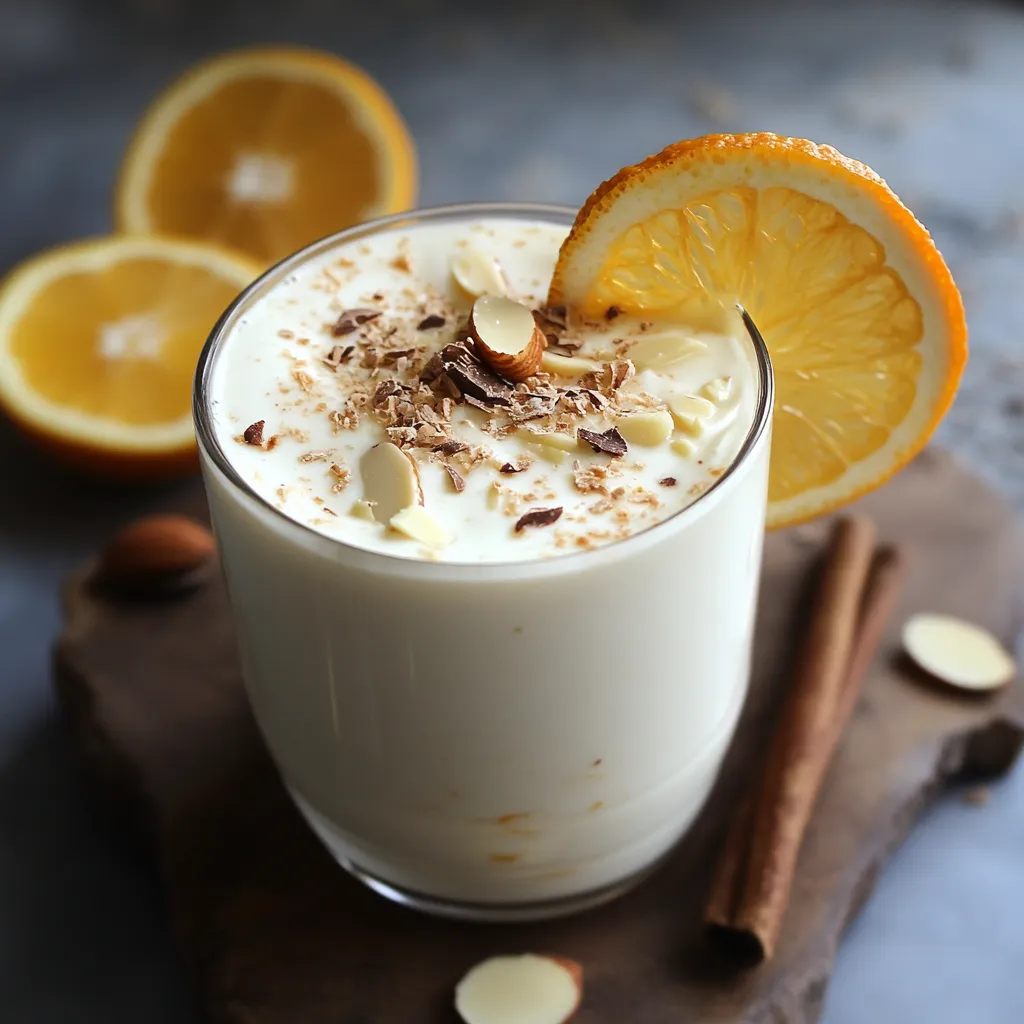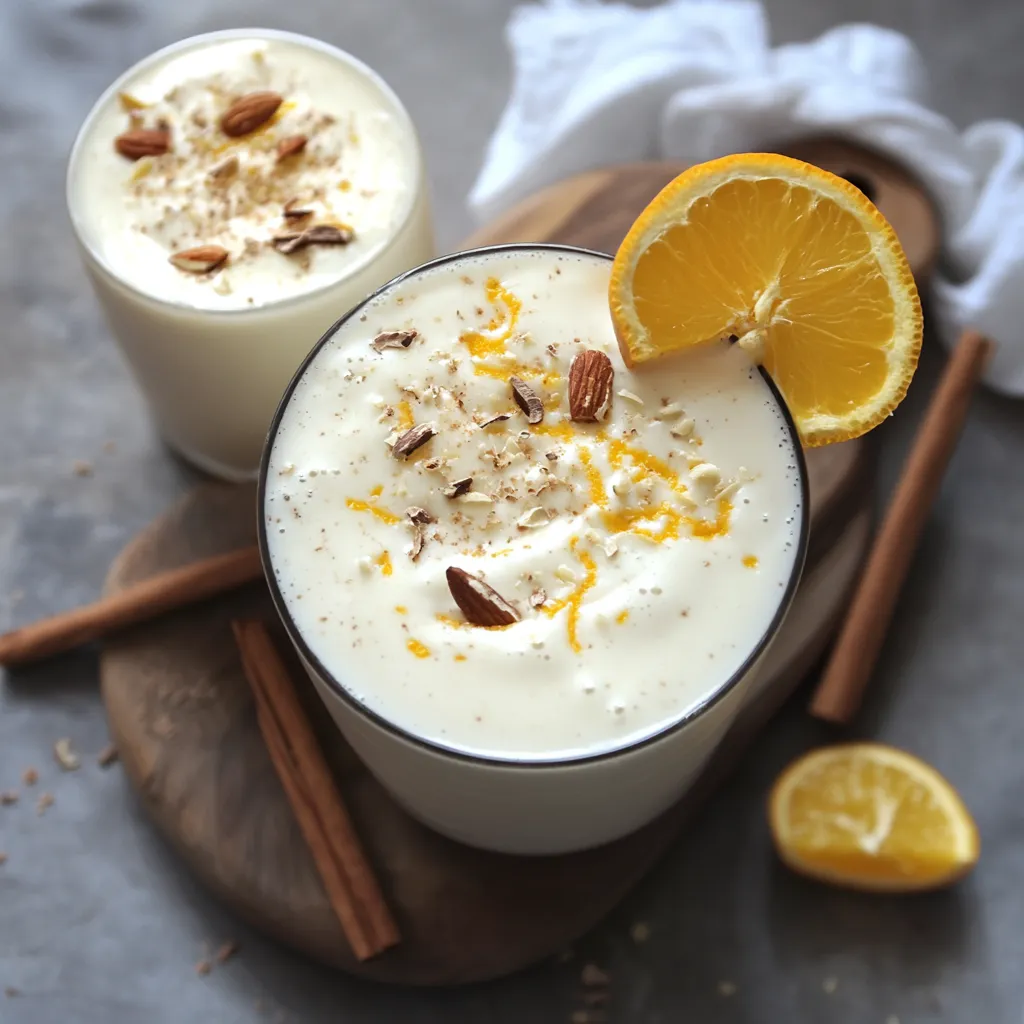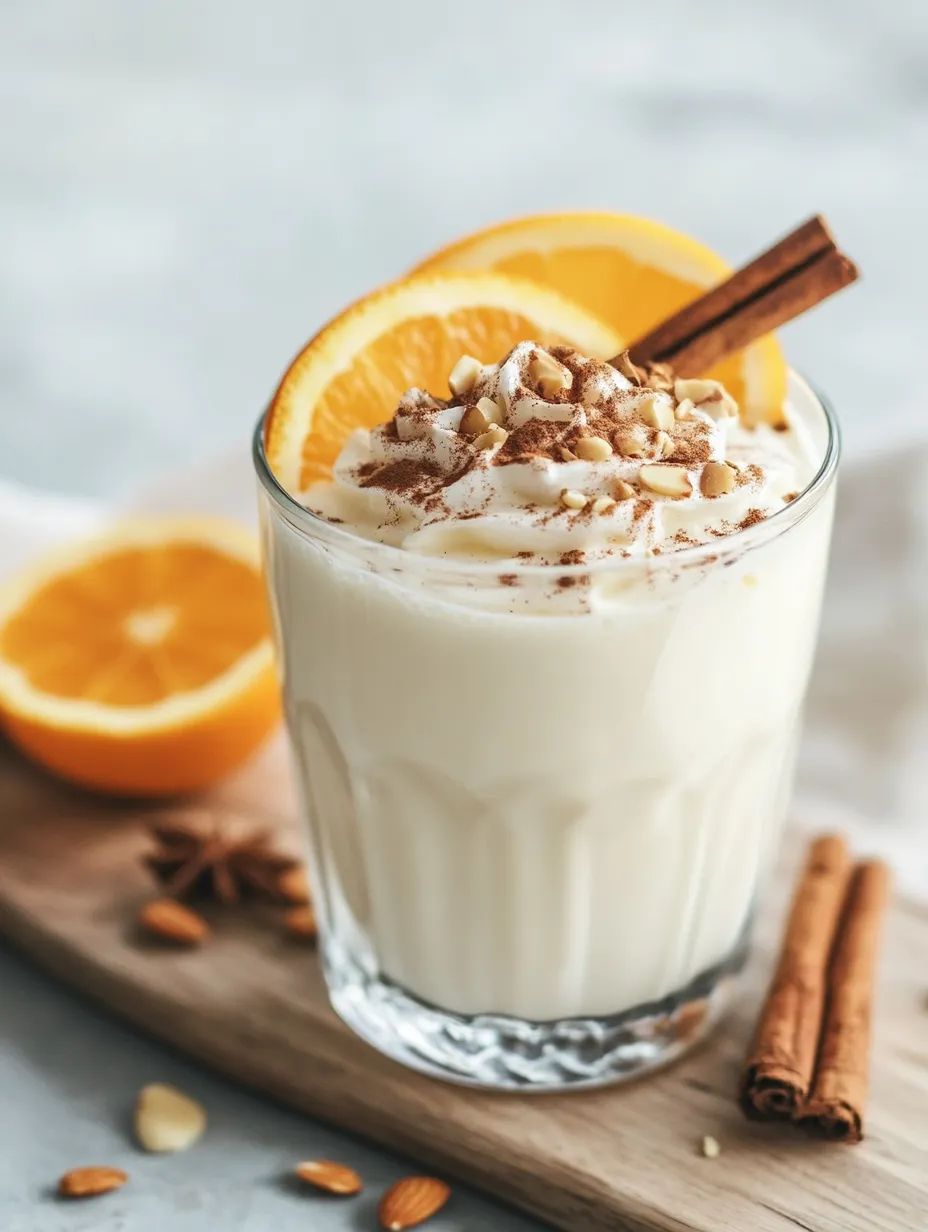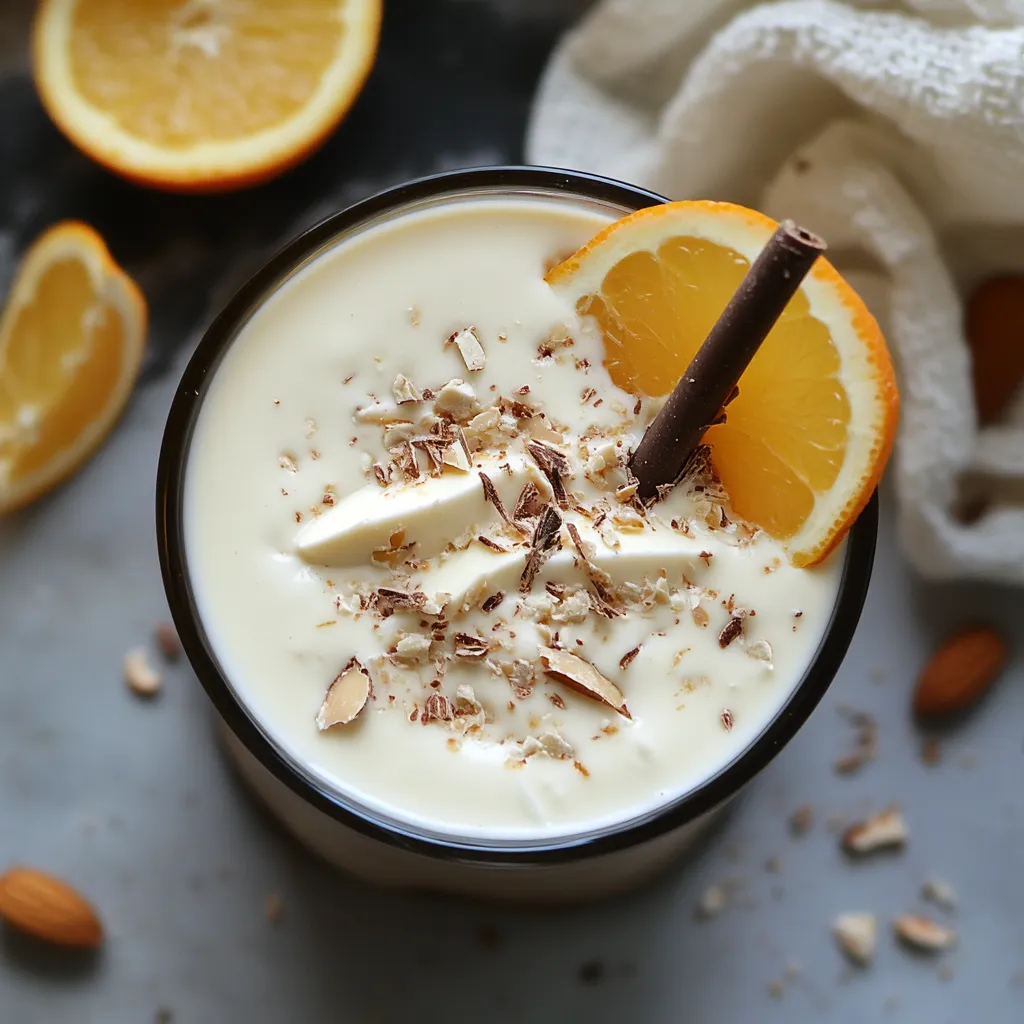 Pin it
Pin it
When white chocolate meets orange, it whisks me back to those cozy childhood winters. But this fancy hot drink takes those familiar tastes and turns them into something truly special. Every sip tells you about the care and top-notch stuff that went into making a drink that feels both snug and classy.
I made this for friends after dinner yesterday, and watching their faces change from curious to thrilled made all my kitchen experiments worth it. The real trick comes down to great ingredients and getting the method just right.
Key Ingredients and Smart Selection Advice
- White Chocolate: Pick only high-end couverture white chocolate containing at least 30% cocoa butter. Cheaper kinds won't give you that smooth, silky base we want
- Orange: Go for aromatic, unwaxed oranges. You need those natural oils from the zest to really bring the flavor out
- Vanilla Bean: Get fresh pods for rich flavor that bottled extract just can't match. Look for ones that feel moist and oily
- Almond Paste: Use pure almond paste for thickness and nutty flavor. Stay away from marzipan as it's way too sweet
 Pin it
Pin it
Creating the Perfect Chocolate Base
Start by cutting chocolate into small, even bits no bigger than peas so everything melts the same way. Set up a double boiler with water that's just barely bubbling, keeping your bowl well above the water line. Warm the chocolate slowly until it just melts, staying between 113-118°F. Mix in room-temp almond paste bit by bit, stirring until it's totally smooth.
 Pin it
Pin it
Flavor Soaking Method
Getting the cream right makes all the difference. Warm it just until tiny bubbles show up around the edge - never let it actually boil. Toss in orange zest, vanilla seeds with the pod, and cinnamon. Cover it up and wait exactly 15 minutes. The warmth pulls out essential oils from the zest and vanilla, building complex aromas.
Watching the Heat
Getting a smooth mix needs careful heat control. Your cream mix should be hot but not burning (around 180°F) when you add it to chocolate. Pour through a fine strainer in three batches, stirring from the middle outward. This makes a stable mix that won't break apart.
Putting It All Together
When heating milk for serving, stop just before it boils - about 185°F. Slowly add ganache while you whisk. Using a stick blender creates tiny bubbles that make the drink extra smooth. Pour with a circular motion to naturally create a swirl of cream on top.
 Pin it
Pin it
My Personal Journey
I first found this flavor combo in a tiny Paris chocolate shop, where I tasted white chocolate and orange in a traditional French hot chocolate drink. The chocolate maker there taught me that watching the temperature isn't just about keeping chocolate from clumping - it's about keeping all those subtle flavors that make each sip so good.
Heat Control Skills
You need to watch each heating step carefully. How hot you make the infusion changes how flavors develop - too hot ruins the brightness of citrus oils, too cool won't pull out enough flavor. Look for clues: tiny bubbles just at the edge of the pan mean your cream is at the perfect temp.
Changing With The Seasons
In winter, try using blood oranges for stunning color and rich flavor. Spring works well with Meyer lemons for brightness. Summer might call for fresh lavender, while fall brings warm spices like cardamom or star anise.
Keeping It Fresh
The ganache stays good when stored right. Put it in an airtight container, press plastic wrap right on the surface, and keep in the fridge up to ten days. Let it warm up a bit before using.
Beautiful Finishing Touches
Make white chocolate curls using chocolate warmed to exactly 84°F. Add candied orange peel for fancy flair and stronger flavor. For really special times, I sprinkle edible gold leaf on top for a truly luxurious look.
The Story Behind The Cup
Hot chocolate's journey from ancient Mayan drink to European luxury shows how our relationship with chocolate has changed over time. This version fits into today's craft chocolate world, where technique meets tradition. White chocolate, once looked down on by serious chocolate fans, now stands tall alongside dark varieties in fancy recipes.
Ways To Serve
Use warm cups - cold ones shock the ganache and mess up the texture. Serve with orange-flavored shortbread or toasted almonds on the side. For evening gatherings, a small glass of Cointreau pairs beautifully.
Fixing Common Problems
If your ganache separates, warm it gently while whisking and add a few drops of warm cream. If it's too thick when serving, add warm milk a little at a time. Watch for burnt chocolate smells - once it's burnt, there's no saving it.
Tools That Matter
Your kitchen gear really affects how well this works. Use a heavy pot for even heating when infusing cream. Digital thermometers help you hit exact temperatures. A good quality stick blender gives you the smoothest texture possible.
Prep Ahead Tricks
Make bigger batches of ganache for parties. Be careful when doubling the recipe, keeping all the ratios the same. Store in small containers for quick use. Having this base ready turns regular moments into special ones.
Serving Like A Pro
Try coating your cups with ganache before adding hot milk - this creates gorgeous marble patterns. Practice your pouring technique to make designs like you'd see in latte art using the natural way cream and chocolate separate.
Fun Twists To Try
- Holiday Spice: Throw in a star anise pod and cardamom while infusing the cream
- Berry Bliss: Switch out some orange juice with raspberry puree
- Sweet-Salty Mix: Add a bit of caramel sauce and flaky sea salt
- Tropical Twist: Use coconut cream for some of the heavy
-
Closing Thoughts
Making truly great white chocolate orange hot cocoa means understanding how fat, sugar, and aromatics work together. You need to treat each part with care: melt chocolate gently, infuse cream patiently, and balance flavors just right. After trying countless versions, I've learned that success isn't just about what goes in but how and when you do each step.
Frequently Asked Questions
- → Can I swap white chocolate chips for couverture chocolate?
- You could, but the chips won’t give the same silky result since they have less cocoa butter and more additives. Adding a touch of unsalted butter when using chips can improve texture. If you want the smoothest, richest drink, opt for couverture chocolate with at least 30% cocoa butter instead.
- → What can I use in place of almond paste for an allergy-friendly option?
- Skip the almond paste and add more white chocolate (about 20%). Tahini or coconut cream can work for a different flavor twist, but be cautious of sesame allergies with tahini. The orange and vanilla will still pop with these changes, but expect a new flavor balance.
- → How do I make a version that’s less heavy?
- Try cutting down on ganache - use about two tablespoons per cup instead of three to four. You can also use lighter options like half-and-half in the ganache or swap whole milk for skim or plant-based options like almond or oat milk. Just remember, lighter ingredients can tweak the flavor slightly.
- → Can vanilla extract replace the vanilla bean?
- Sure, a teaspoon of pure vanilla extract works. Add it once you pull the cream off the heat. It won’t match the richness of fresh bean seeds, but a little vanilla bean paste (about ¼ teaspoon) could level it up. Plus, the tiny specks make it look even nicer!
- → What should I do if my ganache turns too thick?
- If it’s too thick, gently heat it over a double boiler (a bowl over simmering water) and whisk in warm cream, a tablespoon at a time, until it thins out. Go slow to avoid splitting the mixture. Aim for a thick, smooth texture like warm honey.
- → What’s the best way to keep leftover ganache base?
- Put it in a sealed container and keep it in the fridge for up to a week. Scoop out what you need and let the rest stay cold. It’ll solidify but melts quickly in hot milk. For longer storage, freeze portions in an ice cube tray, transfer to a freezer bag, and they’ll last up to 3 months. Thaw overnight in the fridge before use.
-
